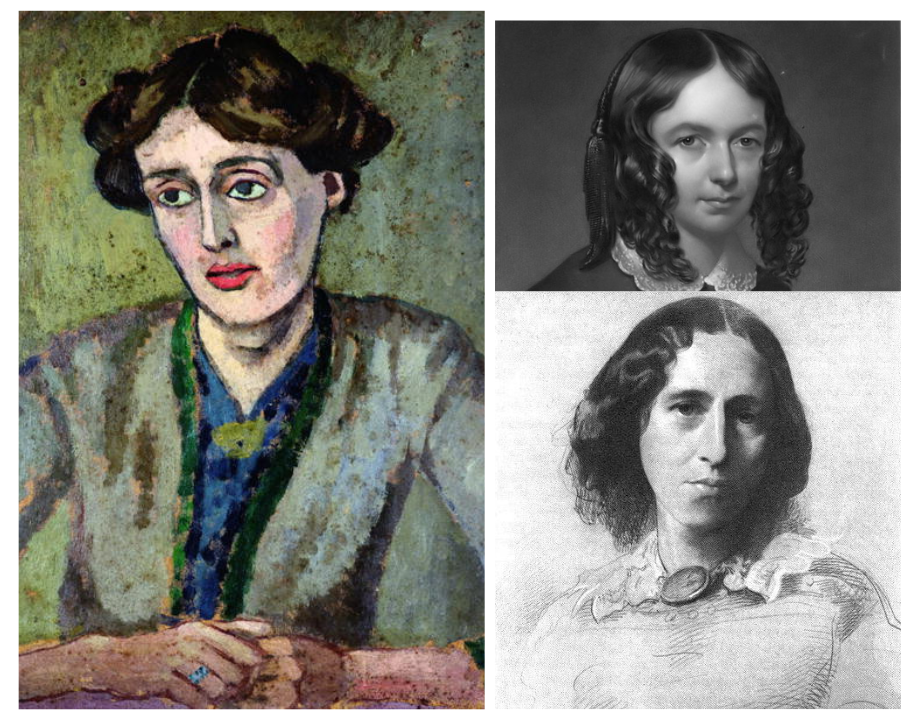The Anglo Saxon Period: Literature and History
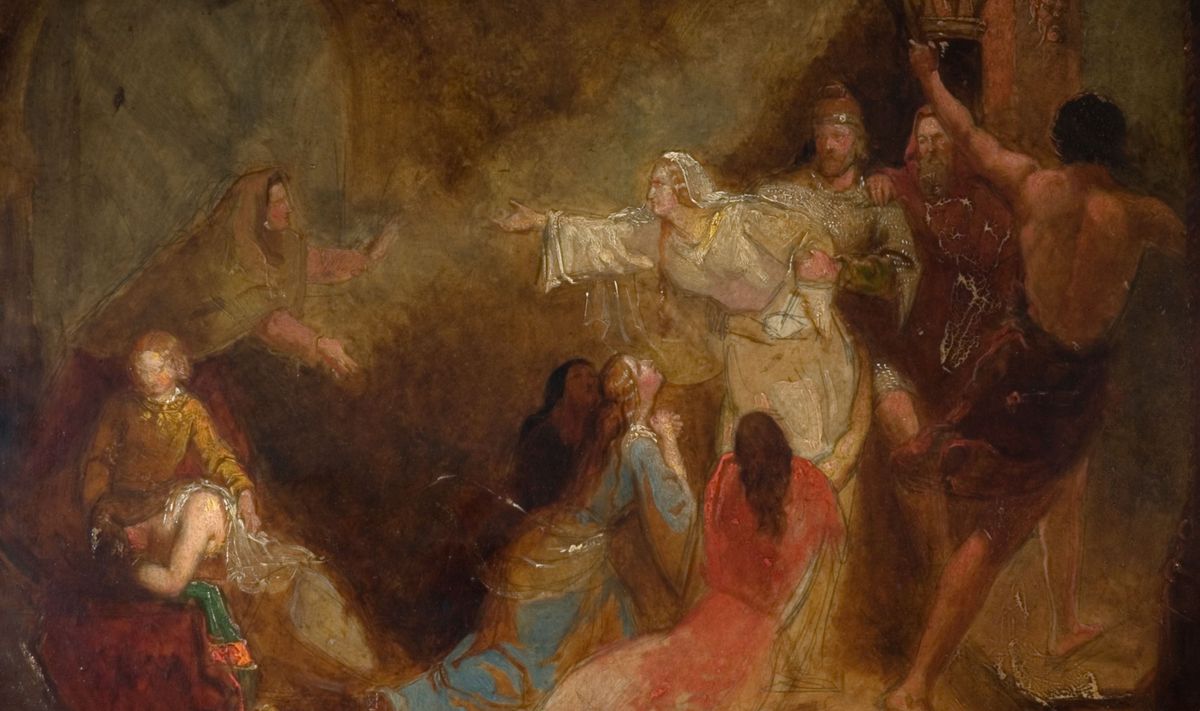
The Anglo Saxon Period in English literature spanned from 410 CE to 1066 CE. Despite coinciding with the Dark Ages of England, it is the foundational period of English identity and language as we know today. Understanding England before and after the arrival of the Germanic Saxons, Angles, and Jutes is indispensable for an understanding of the Anglo Saxon literature.
TABLE OF CONTENT
- The Anglo Saxon Period
- The Anglo Saxon Period in English Literature
- MS Cotton Vitellius
- The Junius Manuscript
- The Exeter Book
- Love Poetry of Anglo Saxon Literature
- Old English Literature The Vercelli Book
England before the Anglo Saxon Period
The Celtic and Gaelic tribes
The Celts
To understand Anglo Saxon period in English literature, we must know about the Celts and the Romans. The Gaelic and Celtic tribes or the Celts lived in England as early as 1000 BC. While the Gaeles spoke Gaelic, the Celts spoke Common Brittonic language and practiced ancient Celtic religion supervised by the druids. It was in the year 43 CE that the Romans invaded and conquered most of England under the leadership of King Claudius. This Roman Empire lasted till the year 410 CE.
The Celtic tribes imbibed and practiced the Roman culture despite the obvious political resistance. Romans too were devoted to England. Afterall, England was an extremely rich and arable land. Additionally, it also had rich metal reservoirs such as abundance of gold in Wales, iron in the Forest of Dean, lead in the North of Wales, Derbyshire, and Yorkshire. On top of everything, the geographical location of England made any attacks and invasions difficult, making it relatively easier for the Romans to maintain their empire.
Arrival and Fall of the Roman Empire in England (43 CE- 410 CE)
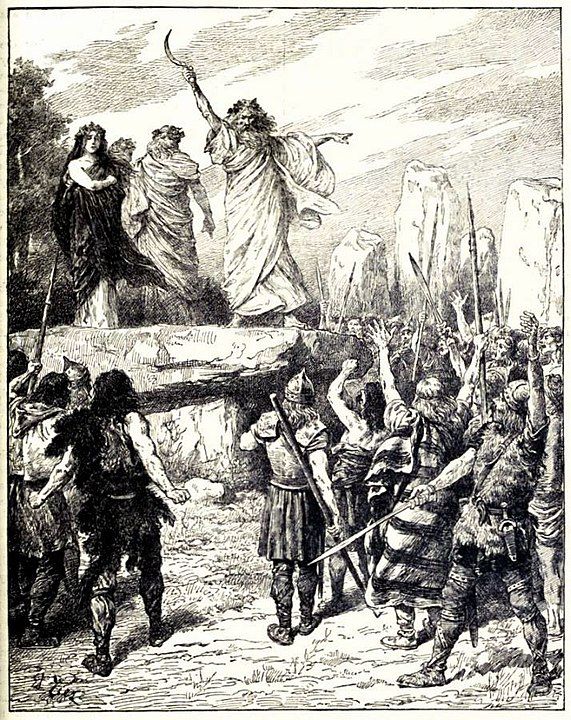
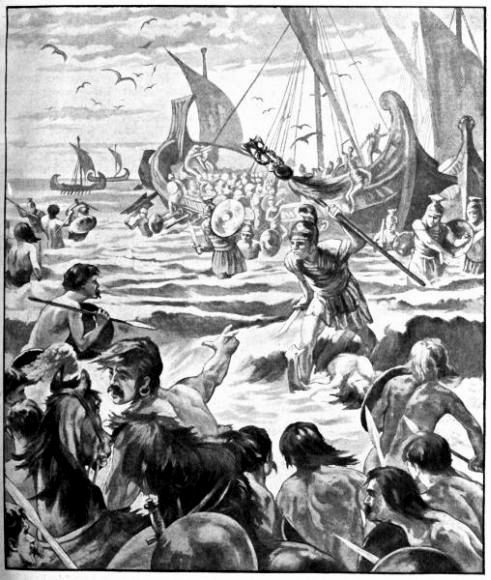
Druids encouraging to fight against the Romans (left) and Romans reaching England (right)
The Romans arrived in England with King Claudius in 43 CE and ruled the country for about 400 years. During this time, England was named Britannia after the Celtic-speaking Britons. Under the Roman empire, England developed roads, towns, and striking forts and walls. Romans also introduced England to foods and fruits such as pear, peas, apples, etc.
The fall of the Roman Empire (410 CE)
The Anglo Saxon began after the Romans retreated from England in 410 CE. The Roman Empire was one of the largest empires in the ancient world that included Spain, France, Germany, Britain, parts of North Africa and Western Asia as well. Undoubtedly, it also became extremely difficult to protect, defend, and rule. In the year 285 CE, the Roman Emperor Diocletian split the vast Roman Empire into two manageable regions:
- The Eastern Roman Empire that included regions such as Egypt, Cyprus, Turkey, Israel, etc. Constantinople (present day Istanbul) was the capital of Eastern Roman Empire.
- The Western Roman Empire included France, Britain, Germany, Italy, etc. Rome was its capital.
In around 407 CE, the Western Roman Empire began to fall apart due to the constant attacks and invasions by the Vandals, Ostrogoths, and Visigoths. In order to safeguard and mitigate the attacks, Roman soldiers had to retreat from Britain and move towards the attacked regions. By 410 CE, every last Roman soldier had retreated from Britain. Another key factor that resulted in the downfall of the Roman Empire was the Huns invasion under King Attila.
The Dark Age in England (410 CE - 1066 CE)
The years after the Romans left England are also known as the Dark Ages. This is majorly due to the absence of any substantial historical record for this time. Nevertheless, it was a crucial period where a new English identity and language emerged. As soon as the Romans retreated from Britain, all the tribes they had repressed and controlled began to raid and attack the island. These invaders were Irish from the West, Picts from the North, and the Germanic tribes (Angles, Saxons, and Jutes) from the East. By the year 500 CE, the Anglo Saxons had invaded most parts of Britain. Therefore, the time period from 410 CE to 1066 CE is known as the Anglo Saxon period.
The Anglo Saxon Period
410 CE to 1066 CE
This section gives a brief overview of the Anglo Saxons The Anglo Saxons were a group of Germanic tribes that ruled England from 410 CE to 1066. They included the Angles who originated from modern Jutland and ruled east, north, and midlands, Saxons who were originally from south of Denmark and east of modern Holstein ruled the south and southwestern regions, and the Jutes who ruled Kent in the southeast. The Celtic tribes who inhabited England before the Roman invasion were now termed as 'Welsh' which meant 'foreigners' in Germanic language. The 'Welsh' continued to preserve their language and culture in Wales and their language and culture is alive to this day.
Society and Religion in the Anglo Saxon period
The Anglo Saxons practiced paganism and worshipped multiple deities such as Norse, Woden, Thunor, etc. The Anglo Saxon society was a rich society where loyalty was the single most important virtue. Marriages used to be political and practical affairs. Women in Anglo Saxon period held an integral position and were considered the weavers of both cloth and the society. They enjoyed hereditary rights to property and even owned kingdoms.
The Anglo Saxons were great poets and were extremely fond of riddles. However, we must note that they did not record or write any of their works. Most of the poetry was meant to be sung and was orally transmitted from generation to generation. Most works were written later by the Roman monks who came to convert England to Christianity in the 6th century.
Christianization of Anglo Saxon England (597 CE approximately)
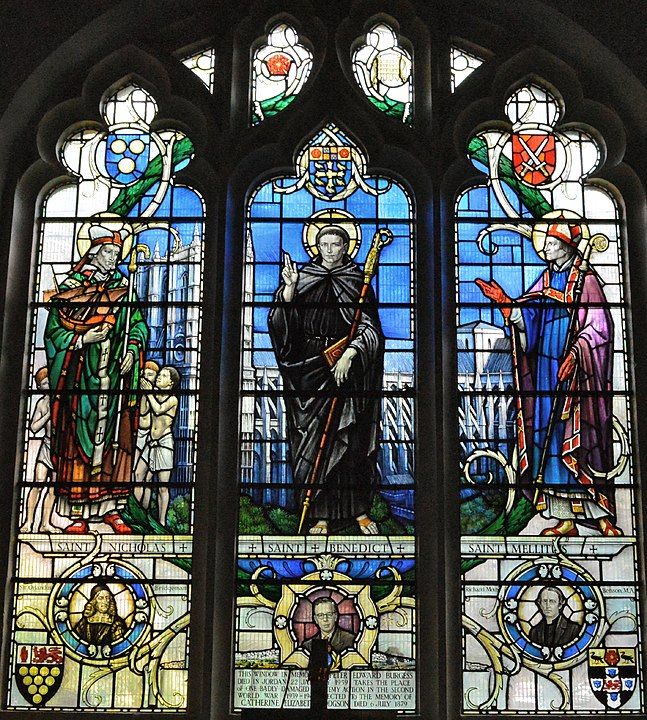
Christianization of the pagan Anglo Saxon society began during the 6th century. It was in 597 CE that Augustine was sent by Pope Gregory to lead the mission of christianization in the south of England and became the first archbishop of Canterbury. On the other hand, the Celtic monks christianized northern England and Scotland. Christianization of England during the Anglo Saxon period had the following consequences:
- There had been no books before Christianity. Books were written because the written word was significant to the Church and the services relied upon the reading of the Holy Scriptures. Therefore, the written word was introduced to the otherwise oral tradition of the Anglo Saxons.
- The Runic alphabets of the Germanic tribes gradually replaced the Roman alphabets.
- Majority of the written literature was in Latin as it was the language of the Roman Church.
- The Anglo Saxon England gained presence and visibility in the mainstream Western European culture due to Latin.
Latin was exclusive to people at high religious posts. However oral literacy remained prevalent among the general population that communicated in Old English. This was the reason why religious instructions for common masses were conducted in English instead of Latin.
Invasion by the Vikings and King Alfred (793 CE)
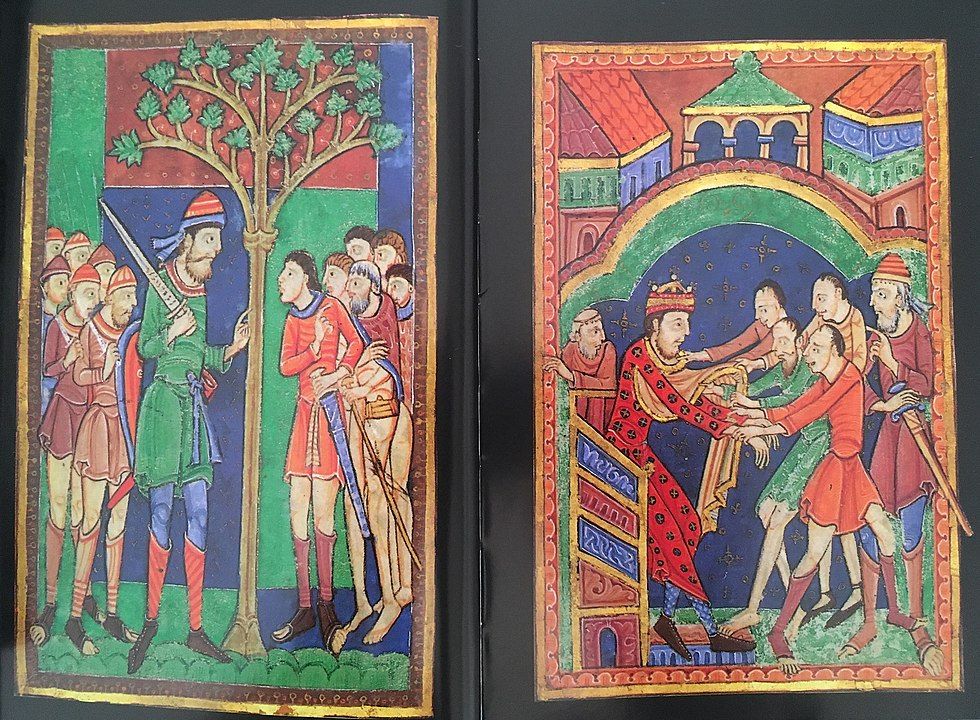
The Vikings raided and attacked England in the year 793 CE of the Anglo Saxon period. Interestingly, they only raided and attacked monasteries as they were guarded by unarmed monks and were vulnerable but rich targets, During this time all the monasteries and libraries housing rich Anglo Saxon literature got destroyed.
King Alfred (848 CE - 899 CE)
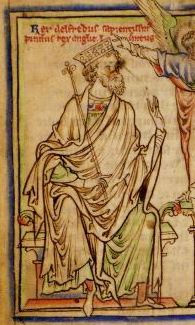
All the damage incurred during the raids and attacks of the Vikings began to get restored during the reign of King Alfred from 848 CE to 899 CE. During this time of the Anglo Saxon period, monasteries were revived and English learning was encouraged. All the four volumes of Old English verses belong to this period. These four volumes are:
- The Junius Manuscript
- The Beowulf Manuscript
- The Vercelli Book
- The Exeter Book
These volumes of Anglo Saxon literature contain poetry composed by diverse unknown poets belonging to diverse backgrounds. They display wide-ranging, layered and complex poetry that was popular during the Anglo Saxon period.
Anglo Saxon Period in English Literature or Old English literature
Features and Complete list of Works
Characteristics of Anglo Saxon poetry and prose
Anglo Saxon literature is dominated by either heroic or epic poetry written in alliterative verses, or religious poetry with heroic elements in it. While prose did not exist until the reign of King Alfred, Anglo Saxon heroic and religious poetry were prevalent in the period.
Anglo Saxon Heroic poetry
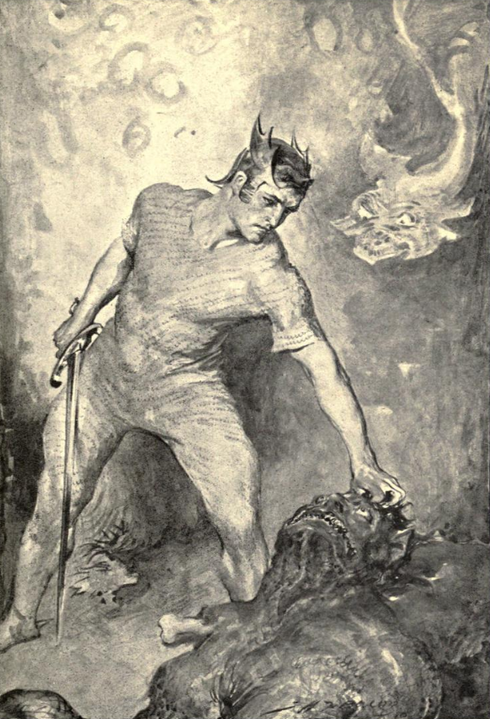
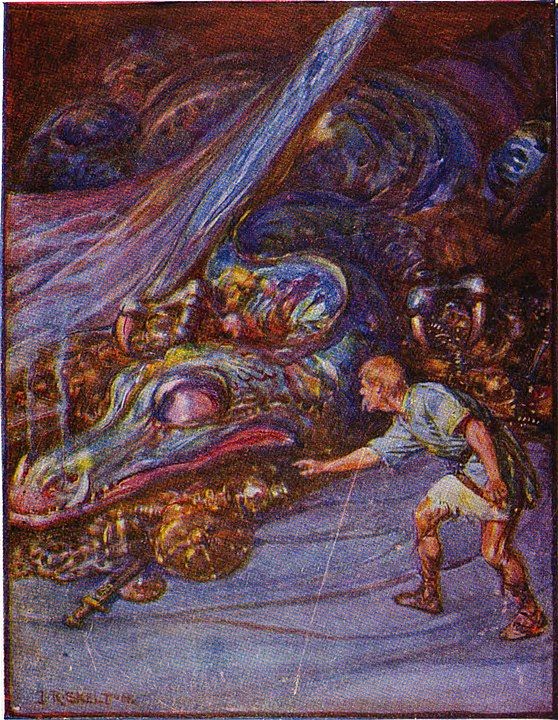
Beowulf killing Grendel (left) Slave stealing the cup from the dragon (right)
Heroic Poetry is “a long narrative poem celebrating the great deeds of one or more legendary heroes, in a grand ceremonious style. The hero, usually protected by or even descended from gods, performs superhuman exploits in battle or in marvellous voyages, often saving or founding a nation…” [The Concise Oxford Dictionary of Literary Terms, 2001, p 82]. The Anglo Saxon heroic poetry gives the readers an insight to the pagan world and culture of the Germanic tribes.
As mentioned above, England was Christianized by the 7th century. In that process, a lot of Anglo Saxon poetry was preserved and written by the monks and many of the pagan elements in the poem were modified or censored. Moreover, most of the Anglo Saxon Heroic poetry is estimated to have survived by sheer chance. The epic or heroic poetry of the Anglo Saxon period emphasizes on the values of tribal communities, and considers loyalty between lord and liegeman as one of the most important virtues. It glorifies individual heroism and highlights the significance of fate in a human's life. It is mostly composed in alliterative verses and is a product of an oral tradition. All Anglo Saxon poetry was meant to be orally recited by a scop or an itinerant minstrel who visited the courts of Kings or often served one master.
Best examples of Anglo Saxon heroic poetry are Widsith, Beowulf, Deor, Battle of Maldon, The Battle of Brunanburh, and Waldhere.
The poem Widsith, is an account of a well travelled scop who gives a detailed account of all the heroes from the Germanic world spanning 200 years. It is a combination of heroic traditions and historical accounts and provides to us an overview of Germanic history and geography.
The most important heroic poetry belonging to the Anglo Saxon period is Beowulf. It is the only complete epic poem in an ancient Germanic language and the only narrative poem that so effectively narrates the Heroic Age of the Germanic tribes. It combines the heroic idealism seamlessly with somber fatalism. The first section of the poem deals with Beowulf assisting King Hrothgar of Denmark against the monster called Grendel and its mother. After successfully slaying the monster and its mother, Beowulf is celebrated and awarded with laurels. In the second section of the poem, Beowulf, who now has been the King of the Geats, encounters a fire breathing dragon. He valiantly and successfully kills the dragon but unfortunately succumbs to his wounds. Even though Beowulf is an Anglo Saxon poem that was composed in England, it transports the readers back to a time before the Anglo Saxon invasion. The heroes of the Geats, Swedes, and Danes are the focus of the poem. Beowulf the most important Anglo Saxon poetry because it perfectly reflects the values of the Heroic Age and even resembles Odyssey in this case. It shares with Odyssey the grand gestures with which men of ranks are received, the generosity of Kings, the loyalty of men, the ambition for fame through courage and performance in wars, and pride in noble lineage. Beowulf exhibits all characteristics of an ideal hero- he is valiant, fierce, stoic, generous and while dying, wishes nothing but the people to remember him. All these factors make this seminal poem an ideal and perhaps the only example of a heroic epic belonging to the Anglo Saxon period.
Deor is another example of heroic Anglo Saxon poetry. It lists various Germanic heroes and how they endured and overcame various hardships. The poem interestingly combines heroic elements with elegiac and personal elements.
Waldhere is another Anglo Saxon heroic poem that was accidentally discovered after 1860. The poem is based on the Waltharius story, well-known to the common people and offers popular stories of Germanic heroes.
The two most important heroic poems written close to the end of the Anglo Saxon period are The Battle of Brunanburh and Battle of Maldon. The Battle of Brunanburh is included in the Anglo Saxon Chronicle and was composed around 937 CE. It is based on the victory of Athelstan and his brother Eadmund against the Olaf the Norseman, Britons of Strathclyde, and Constantine, the king of Scots. This poem is different than the previous Anglo Saxon heroic poetry like Beowulf, Widsith, Deor, etc. This poem is infused with the patriotism. Older heroic poems did not focus much on the nationality of the hero. The hero represented all the Germanian tribes and was equally admired and celebrated by all the Germanic people. This changes in The Battle of Brunanburh. The poem specifically celebrates the victory of the English forces against the Norse, Welsh and Scottish enemies. Athelstan and Eadmund are no longer just individual heroes but are portrayed as the champions of England.
The Battle of Maldon too appears in the Anglo Saxon Chronicle and was composed around 991 CE. It is based on one of many clashes between the English and the Danes that led to the eventual conquest by King Cnut (Canute). The poem is strikingly similar to the older heroic poetry and contains speeches of encouragement for the loosing English army. The poem lists many English warriors by their names, and portrays undying loyalty of men towards their chief effectively. With the Battle of Maldon, the Anglo Saxon heroic poetry came to an end.
Anglo Saxon Religious or Christian Poetry
We know that most Anglo Saxon literature was written during the Christianization of England. The monks who attempted to preserve Anglo Saxon poetry were most likely only focused on preserving religious verses. Hence, a significant amount of poetry that survives today is religious.
By the eighth century, the elements of Anglo Saxon heroic poetry were applied to religious verses. There was a significant transition where the Anglo Saxons left behind the pagan elements and embraced Christianity. The subject of their verses shifted from pagan heroes and heroic themes to Latin Christianity. Most of the religious poetry in the Anglo Saxon period was composed in Northumbria (northern England). Religious poetry in Old English literature is inspired from Latin and gives an English treatment to themes that were common throughout Christian Europe.
According to Bede's Ecclesiastical History of the English People, the very first religious poetry of the Anglo Saxon period belongs to Caedmon. The poem comprises of only 9 lines. It is worthwhile to notice how there is a fundamental shift. Initially, the scop performed and sang for the King or his lord, but this changes and now the focus shifts to God. The heroic style and elements are now being applied to biblical subjects. Verses such as Exodus, Genesis, Christ and Satan, and Daniel, are religious poems that belong to the Caedmonian school, and are included in the Junius Manuscript.
Another important poet of religious Anglo Saxon poetry is Cynewulf. Four of his poems - Christ, Elene, The Fates of the Apostles, and Juliana exist today. In the poems composed by Cynewulf, heroic elements are replaced by contemplative and meditative tones. Cynewulf did not just compose biblical paraphrases, but infused in his works didactic, mystical, and devotional elements and influenced religious poetry to a significant extent. Poems such as Dream of the Rood, Andreas, Guthlac A and B, and the Phoenix, all belong to school of Cynewulf. Another significant religious poem of Anglo Saxon period is Judith.
Lyrical Elegies in Old English literature
Although not as prevalent and popular as the religious and heroic Anglo Saxon poetry, there also exists lyrical elegies in Old English literature. The Wanderer and The Seafarer are the two poems where moods of lament, retrospection and melancholy dominate. Nevertheless, both the poems end with conventional moralising.
Anglo Saxon Writers and their Works
This section includes an exhaustive list of important works of Anglo Saxon literature. Anglo Saxon period in English literature includes heroic and religious alliterative verses and prose. Most of the Old English poetry is in West Saxon dialect. This section includes an exhaustive list of Anglo Saxon poetry and prose. During the invasions of England by the Vikings, a massive amount of Anglo Saxon literature was destroyed by fire. Unfortunately, almost all the poetry belonging to the Anglo Saxon literature is included in four manuscripts-
- The MS Cotton Vitellius: This manuscript contains poems such as Beowulf, Judith, and three works in prose- The Life of Saint Christopher, Wonders of the East, and Letters of Alexander to Aristotle.
- The Junius Manuscript: It contains four poems- Genesis, Exodus, Daniel, and Christ and Satan.
- The Exeter Book: Includes Christ, Juliana, The Wanderer, The Seafarer, Widsith, Deor, and many other shorter poems.
- The Vercelli Book: this manuscript includes Andreas, The Fates of the Apostles, Address of the Soul to the Body, The Dream of the Rood, and Elene.
The section below has a brief overview of Anglo Saxon poems contained in each of the above manuscripts.
Anglo Saxon poetry included in the MS Cotton Vitellius
I. BEOWULF
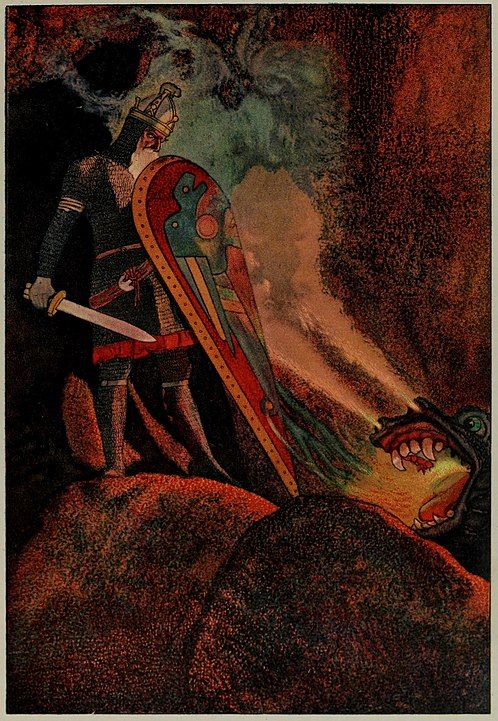
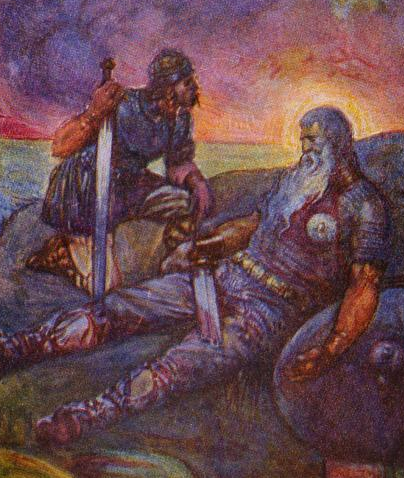
Beowulf facing the dragon (left) and Beowulf approaching his death after slaying the dragon (right)
One of the most important literary works of the Anglo Saxon literature is Beowulf. The poem is a heroic epic with alliterative verse. It is one of the most important and the only existing epic poem of the Anglo Saxon period. The composer of the Beowulf is unknown and it can be divided into 43 sections, also known as fitts.
Beowulf: a brief summary
- The Life and Death of Scyld (lines 1 to 54): The opening lines of Beowulf talk about the life and death of Scyld Scefing, the first great king of the Spear Danes who was found as a baby in a ship. Scyld had a son called Beow Beowulf who was at least as glorious and brave as his father. Upon his death, Scyld Scefing is laid to rest in a ship and is set out to the sea according to his wishes.
- Scyld’s Successors-Hrothgar’s Great Mead-Hall (Lines 55-116): Beow Beowulf succeeds his great father as the king of Spear-Danes and rules the kingdom efficiently for several years. Beow had three sons - Hrothgar, Heorogar, and Halga, and a daughter Elan who became a loved queen to the Swedish King Onela. Horthgar eventually became an extremely successful and victorious ruler of Spear-Danes. He decides upon the construction of a magnificent and lavish mead-hall in order to feast and celebrate. The hall is named Heorot. The celebrations and happiness of the Danesmen is cut-short when Grendel, a monster jealous of the blissful existence of the Danesmen, attacks the mead-hall.
- Grendel, the Murderer (lines 116-189): Grendel attacks Heorot and kills 30 heroes. The whole kingdom drowns in fear, sorrow, and agony. Grendel’s attacks continue for 12 years and makes King Hrothgar miserable.
- Beowulf goes to Hrothgar’s assistance (lines 190-258): Grendel continued in his merciless killings and King Hrothgar was unable to find any solution to this misery. The nephew of King Hygelac, king of Geats hears about the menace created by Grendel and decides to assist King Hrothgar. With an army Beowulf reaches the kingdom of Spear-Danes.
- The Geats reach Heorot (lines 259-320): Upon reaching the Danish Kingdom, Beowulf introduces himself to the Danish coast guards. He informs that he is linked to King Hyglac and is the son of Ecgtheow, a well known warrior. Beowulf then offers his assistance to King Horthgar to help him quell the destruction caused by Grendel. The coast guard welcomes Beowulf and guides him to the palace.
- Beowulf introduces himself at the palace (lines 321-372): This is the section where the name of Beowulf is disclosed for the very first time in the Anglo Saxon poem. Wulfgar, chief of the Wendals and the counselor and herald of King Horthgar asks Beowulf about his intentions and asks his king to welcome Beowulf. Beowulf is warmly received by the king.
- Hrothgar and Beowulf (lines 373-456): This section includes the introductory conversation between Beowulf and king Horthgar. The King welcomes Beowulf and claims to remember his father and him in his younger days. Beowulf declares that just as Grendel uses no weapons, he will too attack and slay him completely unaided.
- Hrothgar and Beowulf continues (lines 457- 499): Hrothgar, the king of Spear-Danes remembers Beowulf’s father Ecgtheow. He also discloses the atrocities and horrors by Grendel and the inability of his men to slay him despite their boastful claims. He welcomes Beowulf to the feast and all heroes of the kingdom rejoice with hope.
- Unferth taunts Beowulf (lines 500-560): Unferth, a jealous Thane of Hrothgar gets jealous of Beowulf and attempts to taunt and question him. He mocks and criticizes Beowulf for participating in a swimming match with Brecca as it was life-threatening for both of them. Unferth even adds how Grendel will defeat Beowulf just as Brecca had defeated him in the swimming match. Beowulf gives a befitting reply to Unferth.
- Beowulf Silences Unferth-Glee is high (lines 561-663): Beowulf claims how he has always been victorious and has won many fierce battles against sea-monsters and silences Unferth by questioning his performance in the battle against Grendel. Finally, King Hrothgar trusts Beowulf and rejoices and celebrates his arrivals. His queen, Wealhtheow welcomes Beowulf too.
- All Sleep save one (lines 664- 713): Everyone retires to sleep and Beowulf prepares to rest too and awaits the arrival of Grendel.
- Grendel and Beowulf (lines 713-794): This section includes the fight between Grendel and Beowulf.
- Grendel is Vanquished (lines 795- 840): Beowulf defeats Grendel and suspends his hand and arm in the mead-hall or Heorot. However, the monster escapes.
- Rejoicing of the Danes (lines 841-929): Beowulf defeats Grendel and is celebrated by all the Danes of the kingdom. He is even considered as the successor to king Hrothgar. Gleemen or singers sing Beowulf’s praises and also of Sigemund who had defeated and killed a fire-dragon. Both Beowulf and Siegmund are praised in contrast to an inefficient Danish King called Heremod.
- Hrothgar’s Gratitude (lines 930-995): Hrothgar expresses his gratitude to Beowulf and declares him as his son.
- Hrothgar Lavishes gifts upon his Deliverer (lines 996-1052): Beowulf and his companions receive expensive rewards.
- Banquet (continued).-The Scop’s song of Finn and Hnaef (lines 1053-1124): Hrothgar’s scop sings about the Danish general Hnaef who was attacked during his stay at the Frisian king Finn’s castle. The scop retells the story of the allegiance between the Frisians and the Danes.
- The Finn Episode continues (lines 1125-1191): This section continues the story of Hnaef and Finn. Hengest, the new Danish general plans to seek revenge for Hnaef’s death, and Guthlaf and Oslaf avenge his slaughter. They kill Finn and take his jewels and his queen Hildeburg. The story concludes and the events of the poem resume. Beowulf is praised and celebrated by the Danish queen too.
- Beowulf receives further Honor (lines 1192-1249): In this section of the Anglo Saxon epic, Beowulf receives even more rewards and appreciation but tragedy awaits them.
- The Mother of Grendel (lines 1250-1320): Since the defeat of Grendel by the hands of valiant Beowulf, his mother is thirsting to avenge her son. While Beowulf was asleep in another part of the palace, Grendel’s mother captured Hrothgar’s favorite nobleman Aeschere.
- Hrothgar’s account of the Monsters (lines 1321-1381): Hrothgar once again grieves the death of Aeschere, his ideal hero and tells Beowulf about the tragic attack by Grendel’s mother. King Hrothgar once again asks Beowulf for help.
- Beowulf seeks Grendel’s Mother (lines 1382-1468): Beowulf along with King Hrothgar embarks on the journey to kill Grendel’s mother.
- Beowulf’s fight with Grendel’s mother (lines 1469-1550): This section of the epic from the Anglo Saxon period includes a fierce battle between Beowulf and Grendel’s mother.
- Beowulf is double conqueror (lines 1551-1640): Beowulf kills Grendel’s mother with a giant sword and chops off the head of Grendel, thereby being doubly victorious.
- Beowulf brings his trophies.-Hrothgar’s gratitude (lines 1641-1734): Heorot is finally free from monsters and Hrothgar praises Beowulf once again.
- Hrothgar moralizes-rest after labor (lines 1735-1804): Hrothgar talks about his reign and all the sorrows and joys while Beowulf rests. The Geats now prepare to leave Danish land and Unferth gifts his sword to Beowulf.
- Sorrow at Parting (lines 1805-1875): Beowulf is bidden a sorrowful farewell and he resolves to always be available to help the king. Hrothgar praises him profusely and grieves the departure of Beowulf.
- The Homeward journey-the two Queens (lines 1876- 1946): Beowulf along with his men return to their country Geatland. Hygd, the queen of Higelac, King of Geats is compared with King Offa’s queen Thrytho.
- Beowulf and Hygelac (lines 1947-2015): Beowulf is welcomed by Queen Hygd and King Higelac asks him about his adventures in the Danish kingdom. Beowulf narrates his battle with Grendel and his mother.
- Beowulf Narrates his adventures to Higelac (lines 2016-2124): This section of the epic poem from the Anglo Saxon period continues Beowulf’s account of his encounter with Grendel and his mother, and how he was showered with praises and expensive rewards from King Hrothgar and his queen after his victory.
- Gift-giving is mutual (lines 2125-2198): Beowulf lays all his gifts at his king Hygelac’s feet. He also gifts the necklace given to him by Wealhtheow to queen Hygd. After the death of Hygelac and his son Heardred’s murder, Beowulf becomes the King of Danish land and rules for fifty years.
- The Hoard and the Dragon (lines 2199-2287): Beowulf’s peaceful reign is interrupted by a dragon who had guarded an underground barrow of treasure for 300 years. Once a slave encounters the hidden treasure and steals a cup from it. This infuriates the dragon and being unable to catch hold of the thief, it begins to destroy the land and buildings along with Beowulf’s hall.
- Brave through aged-Reminiscences (lines 2288-2363): Beowulf hears of the destruction caused by the enraged dragon. He determines to fight alone and remembers Hygelac’s death and his son Heardred’s inefficiency to rule the kingdom. Eanmund and Eadgils pay Beowulf a visit.
- Beowulf seeks the Dragon- Beowulf’s reminiscences (lines 2364-2429): Beowulf sets to find the dragon with 11 of his men. He remembers his life.
- Reminiscences (continued)- Beowulf’s last battle (lines 2430-2564): Beowulf remembers how he was offered the throne by queen Hygd after the death of King Higelac since their son Heardred was too young. Beowulf refuses to take over the throne and rather loyally serves and counsels King Heardred. He succeeded to the Danish throne after Heardred was killed in a feud with the Swedes. Beowulf now battles the dragon.
- Wiglaf the trusty-Beowulf is deserted by friends and by sword (lines 2565-2652): During the battle with the dragon, all his men leave his side except for Wiglaf. The battle continues.
- The Fatal struggle-Beowulf’s last moments (lines 2653-2708): Beowulf defeats the dragon but is fatally wounded himself. He regrets not having a son and successor and is comforted by Wiglaf.
- Wiglaf plunders the dragon’s den- Beowulf’s death (lines 2709-2775): Beowulf succumbs to his wounds and dies with a hope that he will be remembered by his people.
- The dead foes- Wiglaf’s bitter taunts (lines 2776-2842): Wiglaf mourns the death of Beowulf and chides those who had deserted their leader and king.
- The messenger of Death (lines 2843-2892): Wiglaf sends the tragic news of Beowulf’s demise.
- The messenger’s retrospect (lines 2893-3004)
- Wiglaf’s sad story -Hoard carried off (lines 3005-3080): A funeral pyre is created for Beowulf
- The burning of Beowulf (lines 3081-3125): This is the last section of the Anglo Saxon epic and includes the final rites and funeral of Beowulf, an ideal king.
II. JUDITH
The Anglo Saxon poem Judith is based on the Latin text of the Book of Judith included in the Bible. This religious and heroic poem is included in the Nowell Codex manuscript of the The MS Cotton Vitellius and its date and poet are unknown. We only have the concluding sections of the poem.
Historical context: The Assyrians had been attacking and looting the city of Bethulia and were ruthlessly killing Israelites who are the descendants of the Biblical patriarchs and matriarchs.
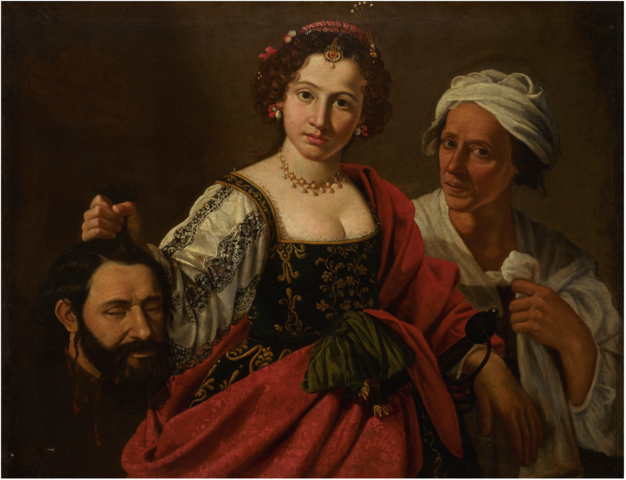
The extant poem begins with Judith of Bethulia praying to God for strength and courage to execute her plan of defeating the Assyrians. The poem includes details about the feast hosted by the Assyrian general Holofernes for his army. He orders his men to bring Judith for his sexual gratification. Judith is brought to Holofernes but due to God's will, is unable to exploit her and falls in a drunken sleep. Getting her courage from God, Judith takes a sword and beheads Holofernes. She takes his head, puts it in a bag and sets off for Bethulia with her servant. There, she displays Holofernes' severed head, tells the general masses how God had helped her, and motivates the people to fight off the Assyrians. Encouraged by Judith's speech, the men of Bethulia prepare to battle the Assyrians.
The Assyrians are still in their drunken stupor when the Hebrew army approaches and are attacked. When the Assyrian men reach Holofernes to tell him about the attack, they find his dead body, putting an end to all their hope.
Assyrians are defeated by the Israelite soldiers. Upon their victory, the Hebrew soldiers reward Judith with the bloody armor of Holofernes. However, Judith only seeks for a reward in heaven by her Almighty.
Anglo Saxon poetry included in the Junius Manuscript
The Junius manuscript was formerly known as the 'Caedmon manuscript' as it was formerly believed that these poems were composed by Caedmon. First three poems- Genesis, Exodus, and Daniel are based on Old Testament story. The Junius manuscript includes religious poetry of the Anglo Saxon literature.
I. GENESIS
The Genesis is the longest of the four poems in the manuscript and consists of nearly 3000 lines with various missing sections. The poem narrates the first twenty-two chapters of Genesis. It is based on Vulgate, Jerome's Latin translation of the Bible and also includes some Christian legend. The poem could have been written by a clerk or a churchman in the early eighth century. Interestingly, the poem also has an interpolation of around 600 lines completely different in style and language. This subsection is called Genesis B, while the rest of the poem is called Genesis A.
Genesis A
Genesis A begins with the creation of Heaven and angel. It includes a brief account of Satan's rebellion, God's rage and His expulsion of Satan from Heaven. The poem ends with the creation of Adam and a description of the Garden of Eden.
Genesis B
Genesis B is like a subtext of 600 lines added to Genesis A. This section deals with temptation and fall of Adam and Eve and a detailed account of Satan's rebellion which was also briefly mentioned in the introduction of Genesis A. Genesis B is strikingly similar and comparable with John Milton's Paradise Lost. The story of Satan's fall has always been a part of Christian tradition despite it not being a part of biblical Genesis. Genesis B has significant poetic imagination and provides a new life to a traditional character. Genesis B is a translation of an Old Anglo Saxon poem written not in English but in Old Saxon.
II. EXODUS
Exodus is one of those Anglo Saxon poetry that demonstrates perfect adaptation of the style and conventions of heroic poetry to religious verses. The alliterative verses narrate the story of the flight of Israelites from Egyptian captivity by the help of God and Moses. It is the oldest poem in the Junius manuscript and is estimated to have been written during the early eighth century.
The Israelites had been thriving in Egypt. Unfortunately, a new Pharaoh comes to power and enslaves the Israelites due to his fear that they will outnumber the Egyptians and will turn against them . Out of this fear, the Pharaoh enslaves all the people of Israel living in Egypt. He also declares that all the boys born to Israelites will be drowned in the river Nile.
A Hebrew women hides her son and he is eventually adopted by the daughter of the Pharaoh. The child is named Moses. Israelites were miserable in Egypt and often prayed to God for mercy. God hears their pleads and assigns Moses to confront Pharaoh. He also asks Moses' brother Aaron to be his spokesperson. Unfortunately, Pharaoh refuses Moses' request to free the Israelites.
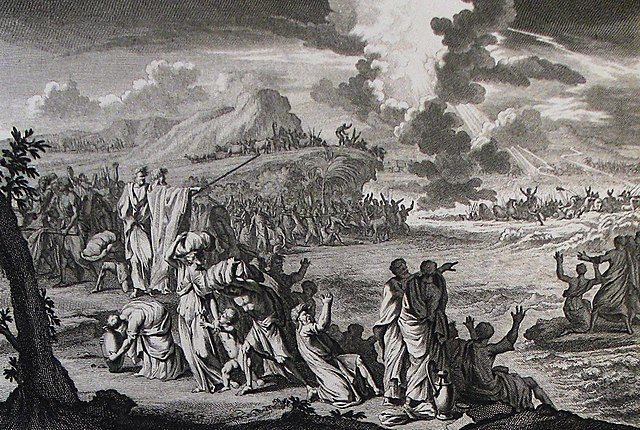
In a terrible plague, God causes all the Egyptian first born males to die. Pharaoh frees the Israelites and they leave Egypt through the Red Sea. God drowns all the Egyptians in the Red Sea when Pharaoh changes his mind and decides to pursue them.
The rest of the poem narrates how God delivers food, safety and protection to the people of Israel and how He gives Moses 10 Commandments for the people to follow.
III. DANIEL
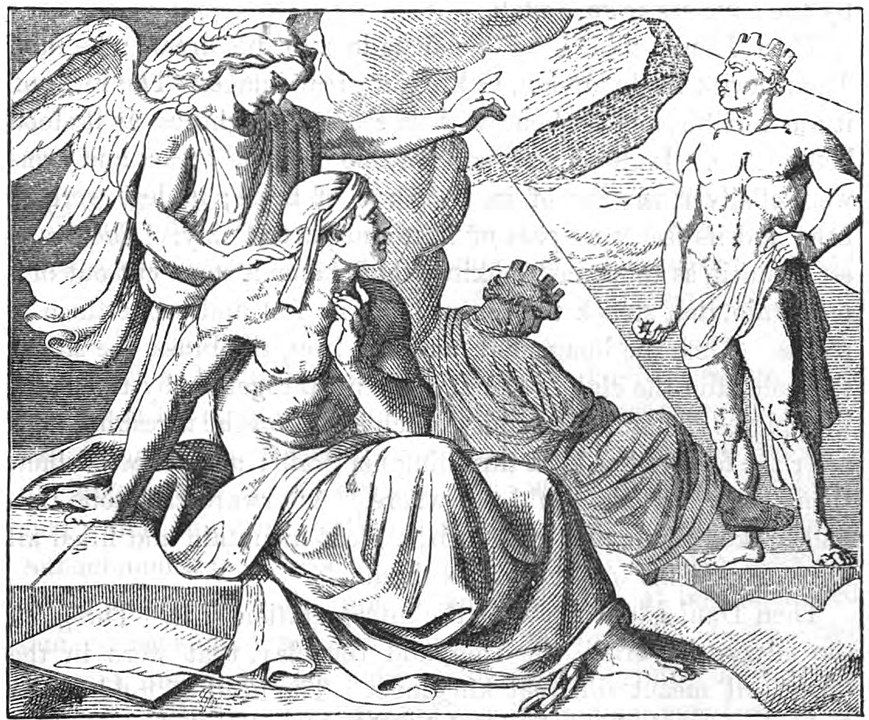
This Anglo Saxon poem is based the first five chapters of the Book of Daniel in Vulgate and contains 769 lines. Many scholars have divided the poem into two parts: Daniel A that includes the retelling of the beginning of Book of Daniel, and Daniel B which is an interpolation. The primary focus of the poem is on the Three Youths- Ananias, Misael, and Azarias, Daniel, and their encounter with Nebuchadnezzar II, the king of Babylon. The opening of the poem narrates how Israelites had become arrogant of their glory. They are conquered as a punishment for worshiping idols and man instead of the God. Daniel is enslaved and is renamed Baltassar. Similarly, Anania, Misael, and Azarias are also enslaved and renamed Sidrach, Misach, and Abdenago respectively. The three youths and Daniel become extremely well trained and are placed highly in the court by Nebuchadnezzar. Daniel interprets the dreams of Nebuchadnezzar and tries to tell him about his unchecked pride but all his attempts are futile.
Eventually, God causes Nebuchadnezzar to lose his throne to Cyrus the Mede due to his incorrigible arrogance.
IV. CHRIST AND SATAN
Christ and Satan is another religious poem that is based on various Christian traditions rather than the biblical sources. It was initially believed that the poem is composed by Caedmon but this notion is debatable today. The poem links the Old and the New Testament and is divided into three sections:
- The Fall of Satan (lines 1-365): In this section, Satan and other fallen angels complain to Christ. This is a deviation as Satan usually directs his complains towards God the father, rather than Christ the son.
- The Harrowing of Hell (366-662): This section includes accounts of Resurrection, Ascension, and Last Judgement. It also focuses on Christ's Harrowing of Hell.
- The Temptation of Christ (663-729): This section recalls the temptation of Christ by Satan in the desert.
Anglo Saxon poetry included in the Exeter Book
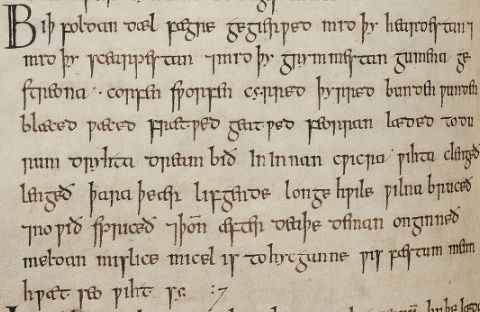
The Exeter book is the largest and the oldest known manuscript of Old English literature and is recognized by UNESCO as a foundational value of English literature.
I. JULIANA
Juliana is one of the four poems attributed to the poet Cynewulf, the other three being Christ, Elene, and the Fates of the Apostles. It is also Cynewulf's longest poem, containing 731 lines. The poem begins with the Christians enduring a tough, repressive and violent life under Galerius Maximian.
Juliana is the daughter of Africanus of Nicomedia and her father had promised her hand to a wealthy senator and friend of Maximian, Eleusias. Being a converted Christian, Juliana is reluctant to marry the pagan Eleusias and publically expresses it. Her father is outraged and allows Eleusias to punish her daughter as he likes.
Juliana is tortured and thrown in a prison where she is visited by a demon in disguise of an angel of God and asks her to commit blasphemy. All these attempts fail as Juliana is steadfast and a faithful Christian. She prays to God for guidance. A voice asks her to seize the demon and Juliana complies.
This is followed by the core of the story: a lengthy verbal battle between Juliana and the demon, where she dominates and wins.
Eleusias returns and offers another chance to Juliana but she resolutely refuses him. This enrages Eleusias and he decides to burn her alive. Miraculously, Juliana remains unscathed from fire. Infuriated, Eleusias beheads Juliana and she becomes a Christian martyr.
II. CHRIST (CRIST)
This poem in Anglo Saxon literature is based on the Homilies of Gregory the Great. It is a lengthy 1700 poem and has three parts:
- Crist I (Crist A or Advent lyrics): This section of the poem has 12 sections and it's poet is unknown.
- Crist II (Crist B or The Ascension): This section is based on the ascension of Christ and is composed by Cynewulf.
- Crist III (Crist C): This poem is about the Last Judgement and is composed by an unknown author
III. THE WANDERER
In this alliterative Anglo Saxon or Old English poem, the Wanderer is in exile at sea and prays to God for understanding and kindness. He recalls the hardships he had endured in his life and constantly thinks about them in his solitude. The Wanderer has no one to share his grief with.
His lord had passed due to old age and had caused the Wanderer to be exiled from the country without a friend or companion. He emphasizes how ruthless loneliness can be.
Towards the end of the poem, the Wanderer says that our lives are entirely dependant on fate . He asks everyone to look up to the Almighty for comfort as he controls the fate of all mankind.
The Wanderer is an apt example of the elegiac mood that was extremely prevalent during the Anglo Saxon period. This poem uses the 'ubi sunt?' motif which was extremely popular in Old English literature. It is about a lonely man who had once been in the service of a lord, and lived a happy and content life. As he ages and after his lord passes away, he is isolated and reflects back on happier times. After the loss of his lord, his country, home, companions, the Wanderer is miserable. The melancholic tones of the poem remind the readers of similar tones in Beowulf. The structure and language of the poem are complex and has several existing interpretations.
IV. THE SEAFARER
Strikingly similar to the Wanderer, Anglo Saxon poem the Seafarer is a monologue of an old sailor who contemplates his life. He reminisces his hardships on the cold rough seas and describes lonely sea voyages. He also draws a contrast between a hard, lonely, and unpredictable life at the sea and the secure, comfortable, and social life on land. As the climate on land gets colder, the seafarer begins to yearns for the sea.
The Seafarer then shifts in tone and topic and now emphasizes that we must steer clear of sins and the devil, and that earthly pleasures will not provide any benefit to a man's soul.
Towards the end, just like the Wanderer, the verses become religious and the poem talks about God, self-restraint, and eternity, and ends with "Amen"
V. WIDSITH
Widsith is one of the earliest surviving Anglo Saxon or Old English poetry. It is an autobiographical account of a scop named Widsith and emphasizes the significance of his function in the court. As Widsith travels far and wide, the poem gives a fascinating account of the Germanic world as it was perceived by the Anglo Saxons. The poem includes many Germanic tribes and mentions characters present in Beowulf (such as Finn and Waldhere). Interestingly, Widsith's account of the Germanic world spans more than 200 years which makes it a fictional autobiography. The poem is in West Saxon dialect and must have been composed in 7th or early 8th century. Another striking feature of Widsith is its catholicity and how heroes in Germanic heroic poetry were not regional but were common to all Germania. Widsith is the perfect amalgamation of historic memories and heroic traditions. It provides us with an overview of a world that was eventually destroyed and partially absorbed by the Roman Empire.
VI. DEOR
Comprising of 42 alliterative lines, Deor is about a scop who served Heodeningas but is replaced by a rival. The poet complains about this injustice and as an attempt to console himself, recalls the troubles of Germanic heroes such as Weyland, Beadohild, Geat, Theodric, and Ermanaric.
He narrates how Weyland the smith had been captured and bound by an undeserving man called Nithhad but eventually overcomes his hardships.
Then, Deor recalls how Beadohild had mourned the death of her brothers and to make her situation worse, she had also found out that she was pregnant. However, her conditions eventually improved.
Next, Deor narrates how Geat had been deeply in love with Maethild, so much so that he was unable to sleep
Similarly, Theodoric the Ostrogoth, king of Maering too had to overcome hardships and struggles during his 30-year reign of the kingdom.
Eormanric the Goth also overcame the problems in his reign despite everyone wishing for him to get overthrown.
Deor then consoles himself that just as these Germanic heroes overcame hardships and hurdles, his situation will improve too.
Deor is one of the only two Anglo Saxon poems that has a refrain.
VII. GUTHLAC A and B
Guthlac A and B celebrate the works and death of Saint Guthlac of Croyland who was a famous saint from Mercia. Both the alliterative poems are consecutively placed in the Exeter Book.
VIII. THE PHOENIX and PHYSIOLOGUS (or BESTIARY)
Composed of 677 lines, the first part of the Phoenix is an adapted translation of De Ave Phoenice by Lactantius. It is a religious poem about the worldly paradise in the East. The first part of the religious poem narrates the beauty of the Phoenix and how it flew to Syria, built a nest, and lived for a thousand years before dying and being reborn.
In the second part of the poem, the phoenix becomes an allegory for the life of virtuous people in their present and future worlds, and for the symbol of Christ.
The poem is followed by another poem titled Physiologus or Bestiary. The poem is a beast allegory where imaginary and real qualities of animals are given moral applications. Beast allegory used to be popular medieval literary form. The poem includes the panther, the whale (named Fastitocalon), and the patridge.
IX. THE RUIN
The Ruin is a 49 lines long elegiac poem that describes a ruined city, speculated to be the city of Bath. The sad images of desolation and decay are contrasted with the extravagant prosperity of an earlier time. The poem invokes a feeling similar to that of Beowulf which also had a strong element of fate.
Love poetry of Anglo Saxon Literature
The Wife's Lament, The Husband's Message, and Wulf and Eadwacer included in the Exeter Book are the only love poems belonging to the Old English literature or Anglo Saxon period.
X. THE WIFE'S LAMENT or THE WIFE'S COMPLAINT
The Wife's Lament or the Wife's Complaint is an Anglo Saxon poem of 53 lines that laments the loss of a lover or a husband. This Anglo Saxon poetry is a frauenlied or a woman's song. It is an elegiac monologue where a wife is mourning the separation from her husband. Since the separation, the woman is forced to live in a forest cave by her husband's kinsmen. The poem effectively expresses a woman's yearning, love, and passion for her husband.
XI. THE HUSBAND'S MESSAGE
Strikingly similar to the Wife's Lament, The Husband's Message is another Anglo Saxon love lyric consisting of 53 lines. It is also similar to the riddles in the Exeter Book because just like in the Anglo Saxon riddles, the readers are expected to guess the speaker of the poem.
In the poem, a piece of wood with a carved message for the wife, narrates its life story and imparts her the message. The husband then recalls how he had been driven away from his wife due to a feud, and also reminds his wife about her vows. He asks her join him across the sea.
XII. WULF and EADWACER
Another love lyric, Wulf and Eadwacer is a dramatic monologue of 19 lines most likely narrated by a female. The speaker laments her separation from her lover called Wulf. The poem expresses an intense passion which is rare in poetry belonging to the Anglo Saxon period.
Other poems and 'Gnomic Verses' included in the Exeter Book are:
- Azarias
- The Gifts of Men
- Precepts
- Vainglory
- The Fortunes of Men
- Maxims I
- The Order of the World
- Riddles
- The Judgement Day I
- Resignation
- The Descent into Hell
- Alms Giving
- The Lord's Prayer
- Homiletic Fragment II
Anglo Saxon Riddles
Besides a collection of poetry, the Exeter Book also includes over a 100 riddles and most of them have been translated from the Latin originals. These riddles were a form of literary amusement but also exhibit excellent literary skills and provide us a detailed account of the world of the Anglo Saxon period.
Anglo Saxon poetry included in the Vercelli Book
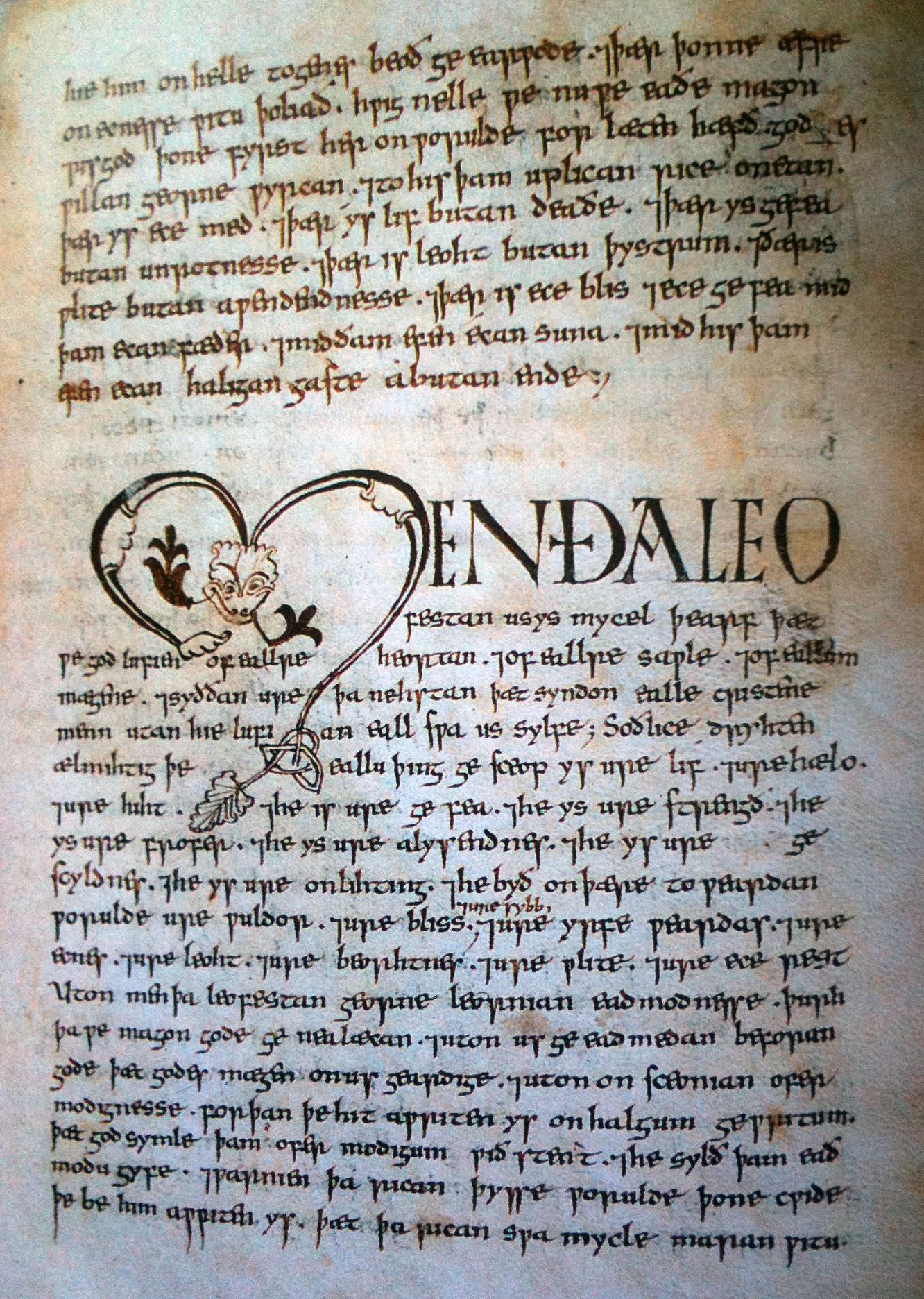
I. ANDREAS
The first in the Vercelli Book, the anonymously written Andreas is an Anglo Saxon poem with 1722 lines. It is one of the poems from the school of Cynewulf and narrates the story of St. Andrew when he saves St. Matthew from Mermedonians, a cannibalistic race. The poem closely resembles Beowulf in its style and tone. It is based on the Latin translation of a Greek work called 'The Acts of Andrew and Matthew in the City of Anthropophagi'.
The first 500 lines of the poem narrate St. Andrew's struggle at the sea in order to rescue St. Matthew. This rescue mission was commanded by God and St. Andrew is accompanied by Jesus and two angels in the disguise of sailors and helmsman. Throughout his journey, St. Andrews endures and loyally relies on God to calm the turbulent seas.
In the second half of the poem, God makes St. Andrew invisible and he releases the imprisoned St. Matthew. After saving St. Matthew, St. Andrew reveals himself to the Mermedonians and is tortured by them for three days. St. Andrew prays to God for forgiveness and is eventually healed by Him, while all the Mermedonians are punished until they repent and convert to Christianity. St. Andrew establishes a Christian church and sails away after appointing a bishop to look after the Church. Just like most poems belonging to the Anglo Saxon period of English literature, St. Andrews too is a religious poetry with heroic elements.
II. THE FATES OF THE APOSTLES
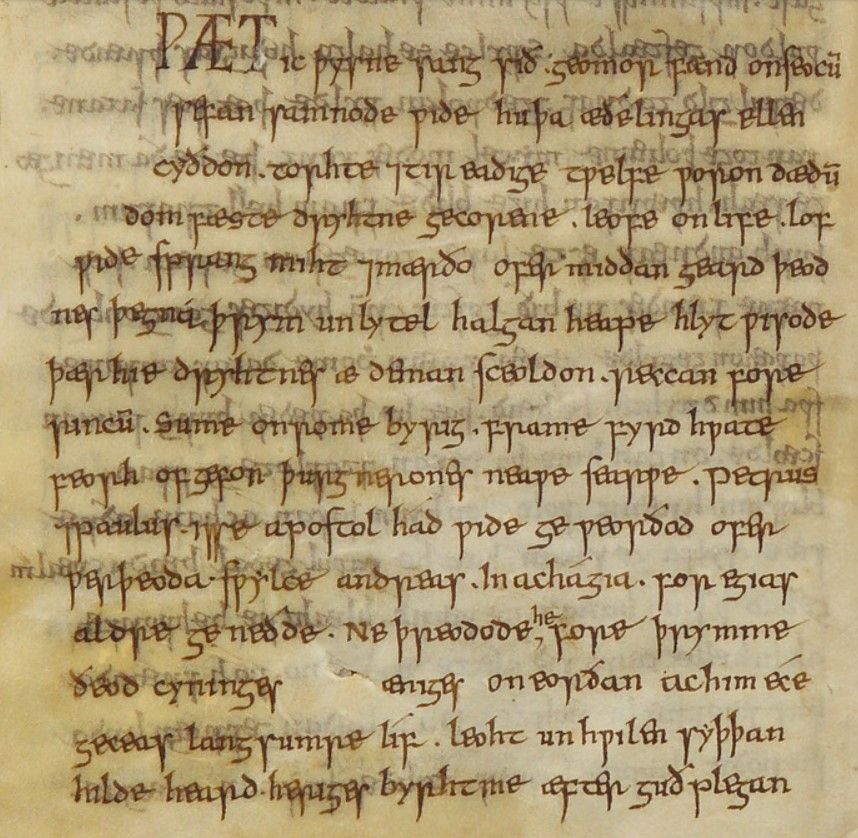
Composed by Cynewulf, The Fates of the Apostles is a short alliterative poem of 122 lines. It narrates significant events in the lives of Twelve Apostles that occured after the Ascension of Jesus. The poem is also considered as a concluding part of Andreas. If so, it is also composed by Cynewulf.
The poem opens with Cynewulf disclosing that he found this poem that had tales of the twelve Apostles displaying extraordinary courage in their journey of spreading the Gospel. The poem mentions Peter and Paul who gave up their lives in a treacherous battle with Nero; Andrew who was crucified in Achaea by Aegeates; John a law abiding man who had worked in Ephesus; James, brother of John, who was martyred in front of Herod; Philip who was crucified in Hierapolis; Bartholomew who refused to worship other Gods and was decapitated by Astrages in Albanum; Thomas who had preached in India, brought Gad, the King's brother back to life and was later killed; Matthew who preached in Ethiopia and was killed by King Irtacus; James who was clubbed to death in Jerusalem, and Simon and Thaddaeus who died in Persia. The poem mutates the heroic elements into a more personal elegiac strain.
III. ADDRESS OF THE SOUL TO THE BODY
Address of the Soul to the Body is an Anglo Saxon poem that has two parts, Soul and Body I that exists in the Vercelli Book , and Soul and Body II that exists in the Exeter Book. Both the poems ask Christian readers to be mindful of their mortal and bodily actions with respect to their impact to the soul's afterlife. Both the poems ask the readers to not be slaves to the desires of the flesh.
IV. DREAM OF THE ROOD
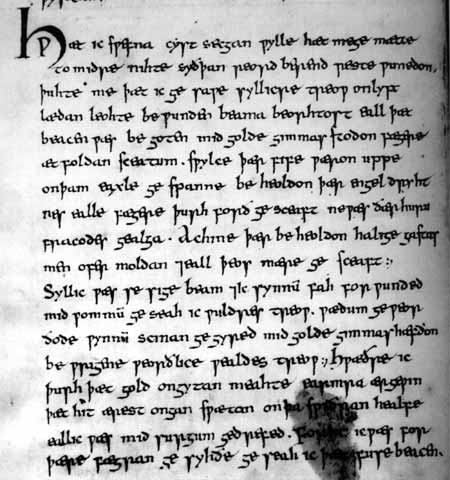
Dream of the Rood is one of the most complex and profound Christian poems of English literature in the Anglo Saxon period. It is also the oldest existing English poem in the form of a vision or dream. The first section of the poem (lines 1-27) opens with a dreamer's vision of a bejeweled cross on which Jesus was crucified, and is worshipped by angels. Looking at the Cross, the dreamer is overwhelmed by a sense of sin and inferiority of his earthly existence. The dreamer also noticed that even though the Cross is adorned with jewels, it also is stained with blood. In the second section of the poem (lines 28-121), the Cross begins to speak and narrates the death of Jesus. The story of Crucifixion is narrated from the perspective of the bejeweled Cross. In the third section of the poem, the dreamer reflects upon his dream and expresses gratitude to God for giving him the privilege of this dream and filling him with hope for eternal life.
The poem is clearly influenced by Cynewulf and exhibits didactic, devotional, and mystical elements.
V. ELENE
Elene is the longest poem composed by Cynewulf (1321 lines) and is based on the story of the discovery of the true cross by mother of Constantine, St. Helena. Elene is also called Saint Helena Finds the True Cross. The poem was composed in West Saxon dialect around 750 CE.
The Battle of Maldon
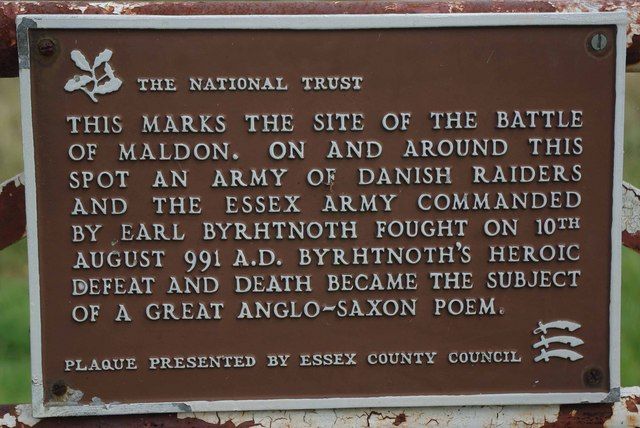
The Battle of Maldon is a poem of 325 lines included in the Anglo Saxon Chronicle and was composed around 991 CE. The poem deals with the various clashes between the English and the Danes. The Danes had attacked England and Danish King Cnut (also Canute) had won the throne in 1016 CE. The Battle of Maldon is strikingly similar to older heroic poetry and it narrates a catastrophic defeat of the English. It contains nine speeches that aim to encourage the English army and many of the warriors are mentioned by their names. The poem displays fierce loyalty and desperate courage against grim odds. The poem abruptly ends with the words of Byrhtnoth. The Battle of Maldon can be perceived as the last of the Anglo Saxon heroic poetry.
Anglo Saxon Literature at a glance
Frequently Asked Questions
Q. What is Anglo Saxon Period in English Literature?
The Anglo Saxon period in English literature spans from 410 CE to 1066 CE. This was the time of the fall of the Roman Empire and the arrival of the Germanic tribes - the Angles, Jutes and the Saxons.
Q. What are the characteristics of Anglo Saxon period in English literature?
The most prominent characterstics of the Anglo Saxon period in English literature are:
a. Heroic or epic poetry, and religious poetry were the most prominent genres of Anglo Saxon literature.
b. The poetry was written in alliterative verses
c. The Anglo Saxons were great poets and riddlers. However, almost all of their poetry and riddles were transmitted orally. It was only after the christianization of England in the 6th century that literature began to be written instead of being spoken.
d. Due to the impact of the Roman Church, majority of high literature was written in Latin. However, religious instructions and poems meant for the masses were composed in English.
e. Hardly any prose was written during this period.
Q. What are the most important works of Anglo Saxon period?
The most important works of Anglo Saxon period are included in four manuscripts – The MS Cotton Vitellius, The Junius, The Exeter, and the Vercelli Book. The most popular works of this period are heroic and religious poems. Among the heroic poems are Beowulf, Widsith, Battle of Maldon, Waldhere, etc. Among the religous poems of the Anglo Saxon period are Judith, The Dream of the Rood, Christ and Satan, Daniel, etc.
Q. What is the theme of Anglo Saxon literature?
Most of the Anglo Saxon literature was written around the heroic themes of honour and loyalty.
References
Greenblatt, Stephen, and Meyer Howard Abrams. The Norton Anthology of English Literature. 2012.
Daiches, David. A Critical History of English Literature: From the Beginnings to the Sixteenth Century. Allied Publishers, 1979.
Baldick, Chris. The Concise Oxford Dictionary of Literary Terms. Oxford UP, USA, 2004
Sanders, Andrew. Short Oxf Hist of Eng Lit 3/E. 2004.
Bennett, Jack Arthur Walter, and Douglas Gray. Middle English Literature, 1100-1400. Oxford UP on Demand, 1990.
The Project Gutenberg eBook of Beowulf: An Anglo-Saxon Epic Poem. www.gutenberg.org/files/16328/16328-h/16328-h.htm#III
“Lesson 1: The Anglo Saxon Period” YouTube, uploaded by CEC, 1 March, 2016, https://www.youtube.com/watch?v=y-a12rE0isM&list=PLpr-GfMI4AAb-kZclSuKmtM0C_SbwRJFc&ab_channel=CEC
“How Did The Romans Change Britain?” YouTube, uploaded by English Heritage, 15 June, 2015, https://www.youtube.com/watch?v=SajyHgJTy3E
“Turning Points in British History-Episode 101-The Anglo-Saxons.” YouTube, uploaded by TBAE network, 23 May 2014, https://www.youtube.com/watch?v=9mJFZabVj_E&t=1218s
English Heritage. “An Introduction to Early Medieval England.” English Heritage, www.english-heritage.org.uk/learn/story-of-england/early-medieval.
Read More
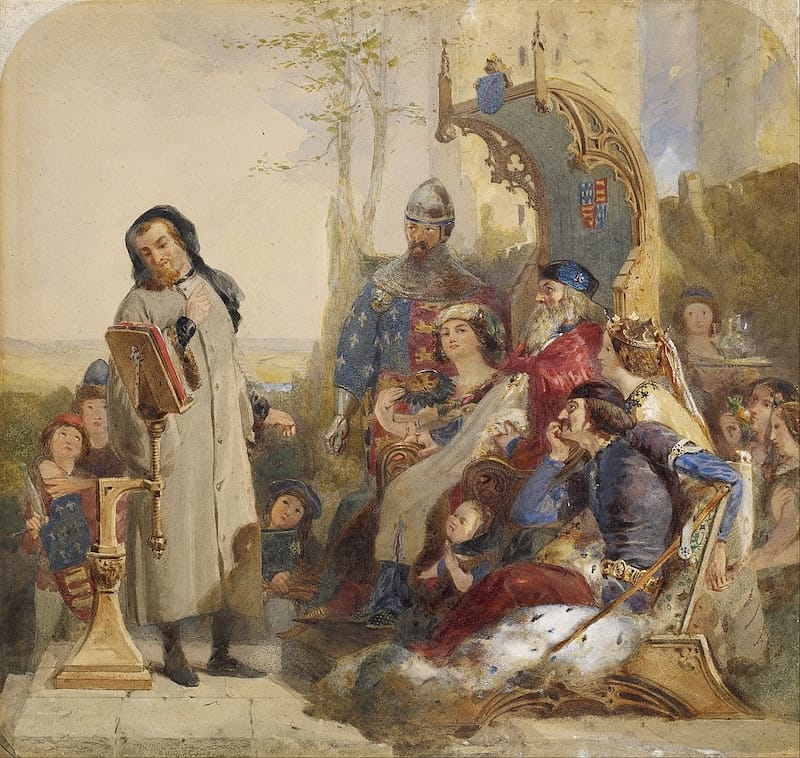
The Age of Chaucer: His Life, Works and their Significance
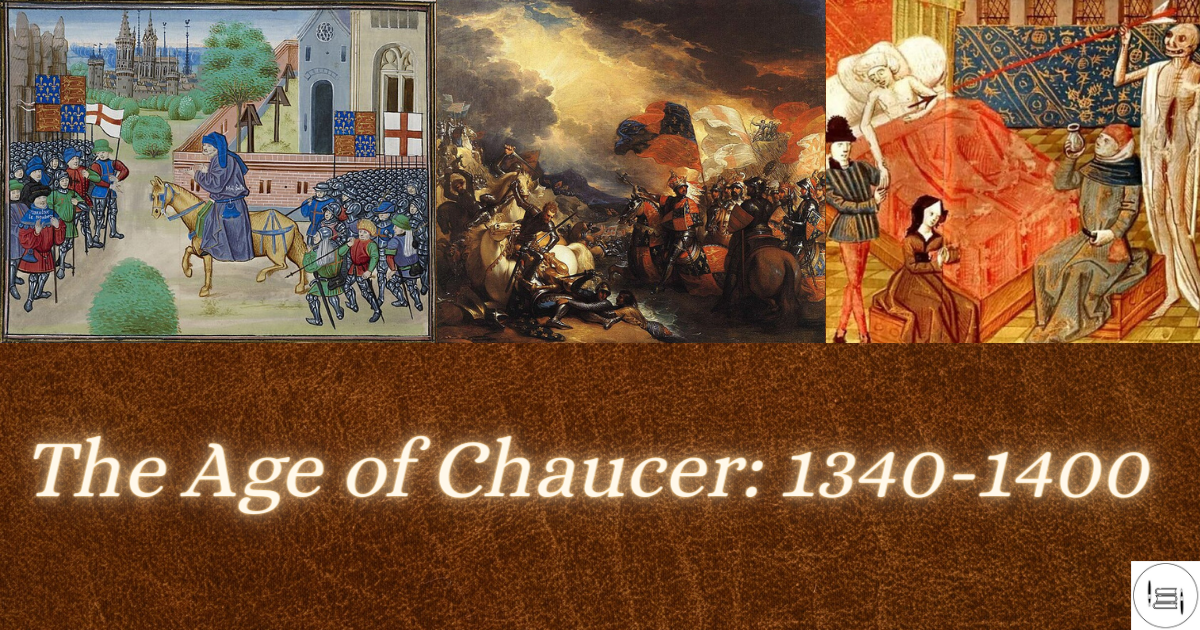
The Age of Chaucer 1340-1400
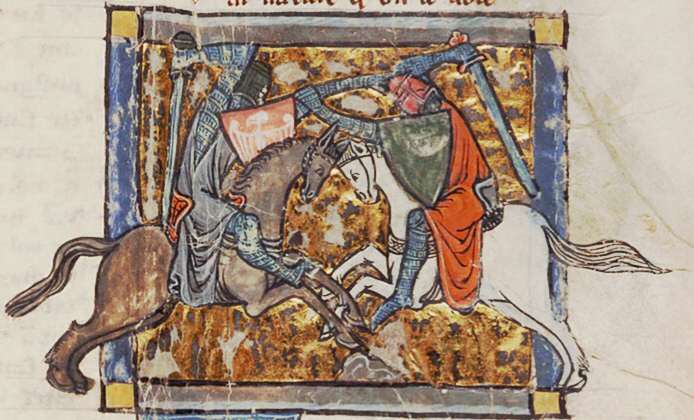
Anglo Norman Literature
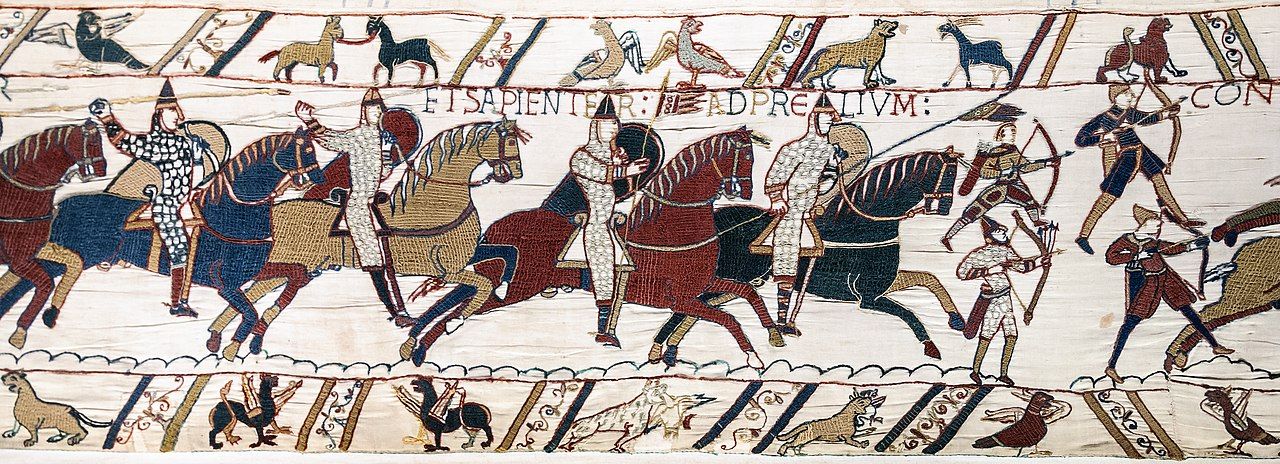
Anglo Norman History

